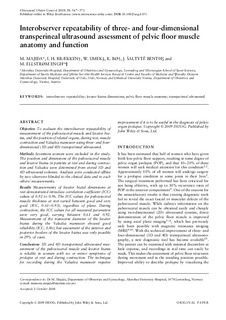| dc.contributor.author | Majida, Memona | |
| dc.contributor.author | Brækken, Ingeborg Hoff | |
| dc.contributor.author | Umek, Wolfgang | |
| dc.contributor.author | Bø, Kari | |
| dc.contributor.author | Saltyte-Benth, Jurate | |
| dc.contributor.author | Ellstrøm Engh, Marie | |
| dc.date.accessioned | 2010-09-02T10:36:27Z | |
| dc.date.available | 2010-09-02T10:36:27Z | |
| dc.date.issued | 2009 | |
| dc.identifier | Seksjon for idrettsmedisinske fag / Department of Sports Medicine | |
| dc.identifier.citation | Ultrasound in Obstetrics and Gynecology. 2009, 33(5), 567-573 | en_US |
| dc.identifier.issn | 0960-7692 | |
| dc.identifier.uri | http://hdl.handle.net/11250/170641 | |
| dc.description | Copyright © 2009 ISUOG. Published by John Wiley & Sons, Ltd. | en_US |
| dc.description.abstract | Objective: To evaluate the interobserver repeatability of measurement of the pubovisceral muscle and levator hiatus, and the position of related organs, during rest, muscle contraction and Valsalva maneuver using three- and four-dimensional (3D and 4D) transperineal ultrasound.
Methods: Seventeen women were included in the study. The position and dimensions of the pubovisceral muscle and levator hiatus in patients at rest and during contraction and Valsalva were determined from stored 3D and 4D ultrasound volumes. Analyses were conducted offline by two observers blinded to the clinical data and to each others' measurements.
Results: Measurements of levator hiatal dimensions at rest demonstrated intraclass correlation coefficient (ICC) values of 0.92 to 0.96. The ICC values for pubovisceral muscle thickness at rest varied between good and very good (ICC, 0.61–0.93), regardless of plane. During contraction, the ICC values for all measured parameters were very good, varying between 0.61 and 0.92. Measurement of the transverse diameter of the levator hiatus during the Valsalva maneuver showed good reliability (ICC, 0.86), but assessment of the anterior and posterior borders of the levator hiatus was only possible in 29% of cases.
Conclusions: 3D and 4D transperineal ultrasound measurement of the pubovisceral muscle and levator hiatus is reliable in women with no or minor symptoms of prolapse at rest and during contraction. The technique for recording during the Valsalva maneuver requires improvement if it is to be useful in the diagnosis of pelvic organ prolapse. | en_US |
| dc.language.iso | eng | en_US |
| dc.publisher | Wiley | en_US |
| dc.subject | interobserver repeatability | en_US |
| dc.subject | levator hiatus dimensions | en_US |
| dc.subject | pelvic floor muscle anatomy | en_US |
| dc.subject | transperineal ultrasound | en_US |
| dc.title | Interobserver repeatability of three- and four-dimensional transperineal ultrasound assessment of pelvic floor muscle anatomy and function | en_US |
| dc.type | Journal article | en_US |
| dc.type | Peer reviewed | en_US |
| dc.subject.nsi | VDP::Medical disciplines: 700 | en_US |
| dc.source.pagenumber | 567-573 | en_US |
